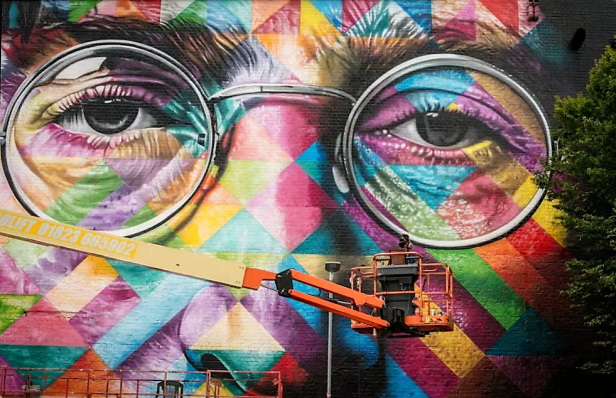We all have heard our grandparents once complaining about « those petty criminals » roaming the streets whilst looking for a big blank wall to draw graffiti on. “Drawing? Who do they think they are? Artists?” they would add. What if graffiti was art, recognized today as street art? And what if street art was part of heritage? I wanted to focus this general study on Eduardo Kobra, a Brazilian artist who has experienced those two phases in his life. First arrested for damaging public places, a judge recognized the quality of his work and thus contributed in launching him into wall painting. Eduardo Kobra is now a famous artist, currently involved in heritage at different stages.
The function of street art, as any other form of art, is unlimited. Kobra is a conscious artist demonstrating a “huge” commitment to several causes. Indeed, Kobra is very popular now and many city councils call for his services in order to “embellish” towns. “Embellishing” would be one way of describing Kobras’ work as he also conveys messages through his art, such as preserving peace, protecting the environment etc.

Artwork by Eduardo Kobra. Miami, United States (2015)
Artwork by Eduardo Kobra, (place & date unknown)
In order to defend their ideas, he also painted some political figures or artists, including Abraham Lincoln, David Bowie, John Lennon and Bob Dylan.

Artwork by Eduardo Kobra. Bristol, England (2017)
Besides making his work part of our current heritage, he also defends cultural heritage from different countries. Eduardo Kobra was asked by the Olympic Committee of Rio to paint a 3,000 square meter mural. He drew his inspiration from several ethnic groups from five different countries. His representation really depicts the spirit and the euphoric atmosphere of the Olympic Games, as well as the jovial Brazilian culture, and the other cultures represented in this joyful and colourful fresco. The Olympics Games is one of the few events in the world which peacefully gathers together almost every country in order to share common interests and Kobra knew how to conciliate his art and this global event to convey his message which could be interpreted in the following way: we are all “equally different” which is what makes us so unique and this is why we all should fight to preserve those specific differences.


Artwork by Eduardo Kobra. Rio, Brazil (2016).
In short, this artist is deeply committed to getting involved in some serious issues that the world is facing and takes part in protecting our differences and our cultures which belong to global heritage. He uses street art as a meaningful way of expressing his ideas and leaving its own mark, or more precisely leaving the mark of our current generation. Eduardo Kobra has successfully managed to unify the world and make people from all over the globe share some aspect we all have in common. Even if the notion of global heritage is not obvious at first , Kobra definitely refers to it representing abstract notions and cultural elements which unify humanity.
References:
- Azzarello. N. (2016). Designboom. Eduardo Kobra paints 3,000 square meter mural for the Rio Olympics. Available: https://www.designboom.com/art/eduardo-kobra-rio-olympics-world-largest-mural-street-art-08-08-2016/. Last accessed 1st October 2017.
- Naveen Ullal. (2016). International Business Times. Available: http://www.ibtimes.co.uk/rio-2016-olympics-opening-ceremony-where-watch-live-date-time-live-streaming-info-1574307. Last accessed: 11th October 2017.
- Mr Mondialisation. (2017). Kobra, le Street-Artist Brésilien Haut en Couleurs. Available: https://mrmondialisation.org/kobra-le-street-artiste-bresilien-haut-en-couleurs/. Last accessed 1st October 2017.
- Nicole Figuerola. (date unknown). Eduardo Kobra. Available: http://www.streetartbio.com/about-eduardo-kobra-biography. Last accessed 1st October 2017.
